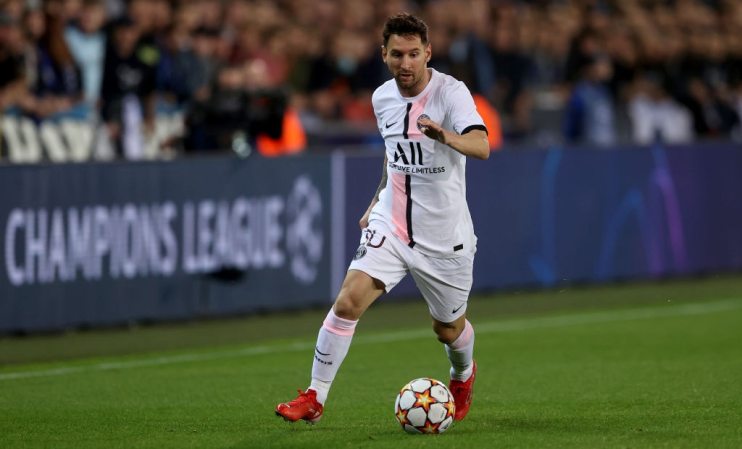Paris Saint-Germain boast bigger stars but Man City have found better way to spend their billions

The subplots will be as numerous as the superstars when Paris Saint-Germain host Manchester City in the Champions League on Tuesday evening.
It’s Qatar v Abu Dhabi in the battle of the state-backed modern-day mega-clubs. Mauricio Pochettino v Pep Guardiola. El Cashico, if you absolutely must.
Fitness permitting, and perhaps most intriguingly of all, it also promises to be Lionel Messi v City, the team that at one stage he seemed destined to join.
City looked close to getting their man in summer 2020, when Messi informed Barcelona of his wish to leave the club he had called home for his whole professional career.
It would have marked the completion of City Football Group’s project to reassemble Barca’s key figures at the Etihad Stadium, which began with the hiring of former Camp Nou executives who in turn lured Guardiola to Manchester.
Messi stayed put for another year, however, and when he did abruptly depart Catalonia last month City had already spent a Premier League record £100m on Jack Grealish.
PSG, one of only three or four clubs who could afford his reported £52m salary, quickly wrapped up the deal.
While the appeal of the world’s best player needs no explanation, signing Messi would have been a break from the established transfer policy at City.
Increasingly since Guardiola took charge in 2016, the club’s recruitment has been focused on players on the up and from clubs outside their clutch of rivals for the Champions League.
It has been short on big names and big egos with millions of social media followers and long on highly accomplished £50m and £60m players, often with two in each position, willing to be cogs in his intricate tactical system.
In fee terms, the Grealish transfer too was something of an outlier, but his profile – improving but yet to peak and signed from a smaller club – was textbook.
PSG have favoured a different approach since Qatar’s sovereign wealth fund acquired the French outfit in 2011.
Especially in recent years, the club has replaced Real Madrid as the most obvious destination for the most individualistic talents who see themselves as brands in their own right.
If Zlatan Ibrahimovic was the prototype Qatar-era PSG player, Neymar, Kylian Mbappe and Sergio Ramos are the new Gallic Galacticos.
In that respect, and although Messi does not invite publicity like those three, Paris is a natural home for the game’s most celebrated and highly-paid star.
PSG and Man City have succeeded at home but not in Europe
Both ownerships have spent well in excess of £1bn on gross transfer fees in pursuit of domestic dominance and, ultimately, the Champions League.
In City’s case, the figure is nearly £2bn, with the club investing an average of £129.5m gross per year on signings since Abu Dhabi took over in September 2008.
PSG have spent £114.5m gross per year in their decade under Qatari ownership, an outlay that has brought them the two most expensive players of all time, Neymar and Mbappe.
They have both achieved the minimum objective for that level of outlay, domestic dominance, albeit to varying degrees.
PSG have won the French championship seven times in the last nine years and current Premier League champions City have accomplished that honour three times under Guardiola.
But Champions League glory has continued to elude them, despite both reaching the final on separate occasions in the last two seasons.
City may have bought fewer superstars but their achievements have been more impressive.
After a season of bedding in, Guardiola has delivered the domestic title in all but one campaign and even then it took a record-breaking performance from Liverpool to deny them.
The standard of competition and level of budget are substantially higher at the top of English football than in France, yet they have largely come to dominate.
PSG have taken a firmer grip on Ligue 1, but such is their financial advantage – their wage bill accounted for 29 per cent of the division’s payroll in 2019-20 – that anything less would be a surprise.
When Monaco in 2017 and then Lille last season broke the Parisians’ stranglehold, it represented a huge upset.
For all of their star quality, PSG have struggled to shake off a reputation for flakiness in Ligue 1 as well as in Europe.
New mega clubs have filled vacuum left by Madrid and Barcelona
All that investment at the Etihad Stadium and the Parc des Princes has, however, helped the clubs achieve other business objectives.
City Football Group have leveraged the club’s success to expand their network of teams in Europe, the United States, Australia and Asia and attract significant further investment.
China Media Capital owns around 12 per cent of CFG, which it bought for £265m in 2015. US tech-focused private equity firm Silver Lake bought a 10 per cent stake in late 2019 that valued the group at $4.8bn (£3.5bn).
PSG, meanwhile, have become a fashion and lifestyle brand as much as a football club thanks to its globally recognised players and deals with Nike’s Jordan arm and, more recently, luxury fashion house Dior.
In the wake of Messi’s arrival, PSG president Nasser Al-Khelaifi promised that the signing had unlocked a slew of other, yet to be announced commercial partnerships.
Maybe Messi will lead his new team to a first ever Champions League title. Or maybe Grealish will prove the missing piece in City’s still-unsolved European puzzle.
But in an era where it is hard to know where brand building ends and on-field priorities begin, maybe it is enough to simply be football’s biggest and best-known club.
The decline of Real Madrid, whose Galactico policy PSG have emulated, and Barcelona, the inspiration for much of City’s work has left a vacuum, and their followers have filled it.
